Sporting scooter purchasing advice: how to choose the right product
- What You Need to Know
- Sporting scooters are pedal scooters. To get around, the rider regularly pushes off the ground with one foot.
- Sporting scooters can be used to cover short distances quickly and easily. They are compact, light, foldable and can be taken anywhere – even on buses and trains.
- Sporting scooters are suitable for children and adults. Important factors are the maximum load capacity and a height-adjustable handlebar.
- The scooters are equipped with either small hard plastic wheels or pneumatic tyres. Hard plastic wheels are mainly suitable for asphalt.
- Users can also ride on uneven surfaces on mini scooters with pneumatic tyres.
Mobile in the big city
Public transport in larger cities is extensively developed and transports countless residents to their destinations every day. But the means of transport do not reach all corners of the city, nor are they insensitive to disruptions. These cause delays and cancellations that sometimes last the entire day. Those who don’t have a driving licence or don’t want to undergo the rush-hour traffic jam, however, have to rely on buses and trains for long distances. Already when changing between stations or for the last stretch before the destination, walking distances occur that not only cost time but are also exhausting for many working people.
Such short distances are ideal for sporting scooters. What many probably know from their childhood is no longer just a children’s toy. In the meantime, sporting scooters are experiencing a real boom: if you want to get from one place to another quickly and do something for your fitness at the same time, you are well advised to use one. Walking is healthy, so is sporting scooter riding, and it’s great fun for young and old alike.
What is a sporting scooter?
Sporting scooters are a subcategory of pedal scooters that impress with their compact dimensions. Scooters are all means of transport that consist of two wheels, a footboard and a frame with handlebars and are driven by muscle power. The rider stands with one foot on the footboard and pushes off the ground with the other. In everyday language, sporting scooters usually describe folding scooters with small wheels made of hard rubber or with pneumatic tyres. The wheels have an approximate size of six to ten inches, but manufacturers give the measurements in millimetres. The small sporting scooters are often designed with 145-, 200- or 230-millimetre wheels. The handlebars can be folded towards the deck so that the scooter can be stored in a space-saving way and easily transported. Other names for this type of scooter are scooter, mini-scooter or city scooter.
While compact sporting scooters look like a two-wheeled skateboard with handlebars, conventional scooters with tyres from a diameter of twelve inches are comparable to bicycles. In principle, they are also suitable for riding in the city. Above all, sporting scooters with a wheel size of no more than 20 inches can also be described, according to broad definitions, as “sporting scooters” – as pedal scooters for use in the city. Some of them can even be folded and can then be found under the designation “folding scooter”. In the following, however, the focus is on compact sporting scooters.
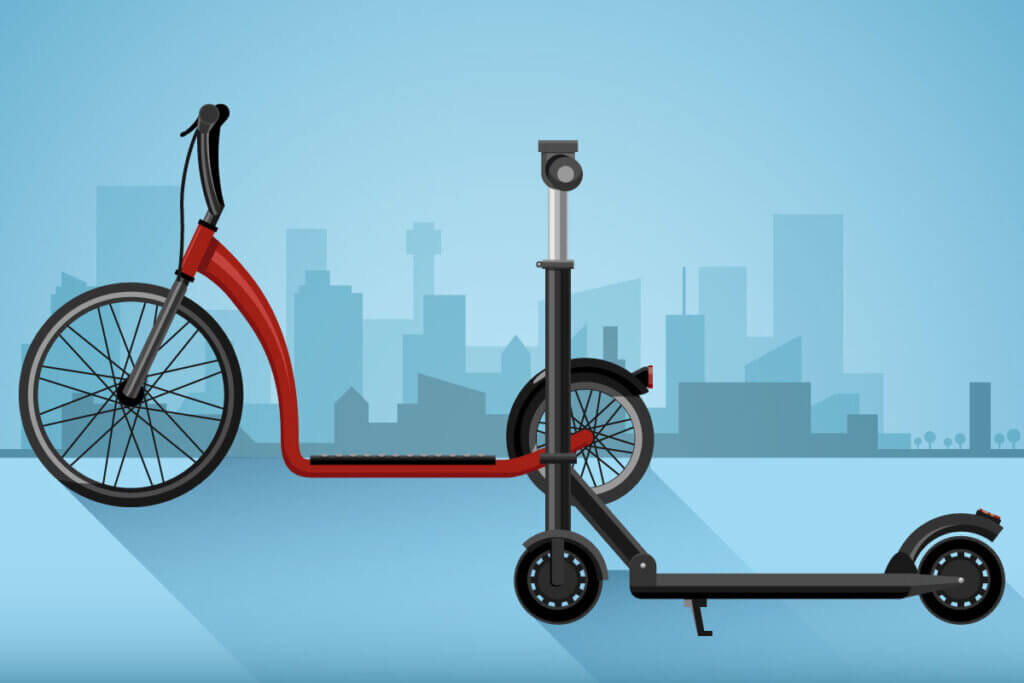
Effortlessly reach your destination with an electric scooter
Electric sporting scooters are compact scooters with an electric motor. Riders do not have to use muscle power to get to their destination quickly. They are therefore ideal for short journeys to work or for city tours. One disadvantage is that the built-in battery is not designed for long distances: the range is 20 to 60 kilometres. In the meantime, there are also some foldable models that facilitate transport on public transport.
Who benefits from the advantages of a sporting scooter?
Compact sporting scooters offer several advantages compared to other means of transport. They are small, weigh only a few kilograms and can be folded. This allows scooter riders to conveniently transport the scooter on the go. In this state, owners can easily take it with them on buses and trains without paying a surcharge. This is because sporting scooters are classified as toys and not as a means of transport. It takes just a few seconds to unfold, so the scooter is quickly ready for use. With prices between 50 and 250 euros, they are also cheaper than bicycles, for example. In contrast to walking, riding a mini-scooter saves a lot of time, and the effort required is limited. Despite the rather low effort, riding a scooter uses various muscle groups, for example in the legs and upper body muscles, and trains balance. It is a fun way to improve your health.
Sporting scooters are suitable for young and old alike. Riding does not require any special knowledge or skills. Special sporting scooters for children or adults usually only differ in handlebar height, maximum load capacity and design – models for adults are usually less playful. For tall or strong riders, there are also XXL sporting scooters with higher handlebars as well as those that can take a heavier load.
The way to work or school can be covered much faster with a mini scooter. Adults and children can use the sporting scooter for the last few metres or for the journey between bus and train. Sporting scooters are also suitable for shopping, which is even easier with the right shopping basket.

However, they are not suitable for all surfaces. A conventional mini scooter with hard rubber tyres performs very well on asphalt, but reaches its limits on cobblestones, for example.
What are the advantages of sporting scooters for children?
Riding a scooter is far from being just a fun leisure activity for children, it promotes their development in several ways. For example, it trains their sense of balance as well as their coordination skills. Children learn to control their bodies better and to react to their surroundings. The distance to the ground is smaller than on a bicycle and braking is easier, which means that children’s scooters have a lower risk of injury. Children train their motor skills in a playful way and learn how to deal with speed. For younger children, this makes it easier to learn to ride a bike later on. A sporting scooter can also be used to cover shorter distances to school or to visit friends: The little ones become more independent.
How to recognise the ideal sporting scooter
Sporting scooters belong to the more compact variants of pedal scooters: Their wheels are smaller and the scooters can usually be folded. In addition, they often come with a carrying strap and a practical stand. Whether you buy a handy foldable or a larger, non-foldable pedal scooter depends on your own requirements for the means of transport as well as the transport possibilities. The following criteria will help you find the right sporting scooter for your area of use.
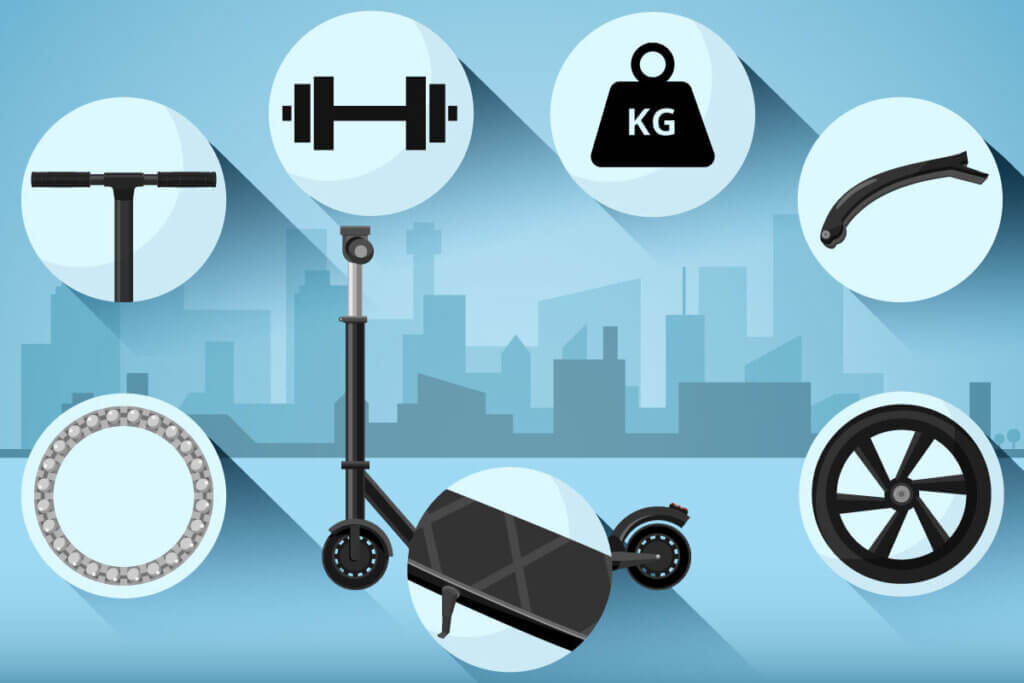
A footboard for safe standing
The footboard, also called the deck, is a central component of sporting scooters: wheels and handlebars are mounted on it. The actual tread surface is dedicated to the user, who stands on the deck with one foot and pushes off the ground with the other.
For an optimal riding experience, a sturdy yet lightweight footboard is recommended. Aluminium is usually used as the material. It should also provide enough space for your own feet. Typical lengths are around 33 to 36 centimetres; for large feet, there are also models with a footboard around 40 centimetres long.
Low decks are particularly comfortable while riding on a rather flat surface: the higher the footboard, the lower the user has to squat while riding, which puts strain on the standing leg. Higher footboards, however, put obstacles away better. A height of five centimetres is considered lower, while more than ten centimetres is particularly high.
One handlebar for all cases
Handlebars, alternatively called bars, are made of aluminium or steel. Aluminium handlebars are characterised by their light weight and are therefore recommended for young or petite riders. Steel handlebars are heavier, but much more robust than aluminium, which can break under heavy load.
The handlebars of sporting scooters are height-adjustable so that children as well as adults can ride comfortably. The range is from about 75 to 105 centimetres, although the exact adjustability varies depending on the model. Some devices have a lower minimum height, such as the City Scooter Tornado from the manufacturer Apollo with 84 centimetres. Others, however, have a low maximum height of less than 100 centimetres.
The handles of many models are pre-assembled and made of foam or rubber. Although softer handles feel more comfortable, they wear out more quickly than harder ones. Ergonomically shaped versions made of sturdy rubber, on the other hand, fit better in the hand and provide a good grip even on longer rides. Some foldable sporting scooters not only have foldable handlebars, but the handles can also be folded inwards. This makes it easier to carry the scooter.
Rollers: Full speed ahead
The size and material of the wheels have a decisive effect on the area of use and the riding experience on the sporting scooter. Compact sporting scooters are equipped with small wheels made of hard rubber or pneumatic tyres.
The hard rubber wheels for the handy scooters often have a diameter of 145 or 200 millimetres. Stunt scooters, on the other hand, have particularly small versions, for example with a diameter of 100 millimetres, as these tyres are better suited for stunts. Hard rubber wheels require a ball bearing to which they can be attached in two ways. In the first method, the hard rubber coating is mounted on a rim with spokes. The second type is common on small wheels for sports use, such as stunt scooters. These have a hole in the centre for the ball bearing.
To adapt the scooter to your own riding style, it is advisable to pay attention to the hardness of the wheels. Hard versions are particularly suitable for tricks on smooth surfaces, while soft versions enable smooth riding even on uneven surfaces. The hardness is specified on the basis of the A scale, which is also used for skateboards. The value 101A describes the hardest wheels, whereas 72A stands for very soft versions. The average hardness for sporting scooters is in the range of 79A to 84A.
Wheels with pneumatic tyres have the rubber tube mounted on a rim. On folding sporting scooters, the tyres have a size of around 200 to 230 millimetres. City scooters, on the other hand, have tyres measuring 12 to 29 inches, about 305 to 737 millimetres. The following applies to all designs: the larger the tyres, the smoother the scooter is to ride.
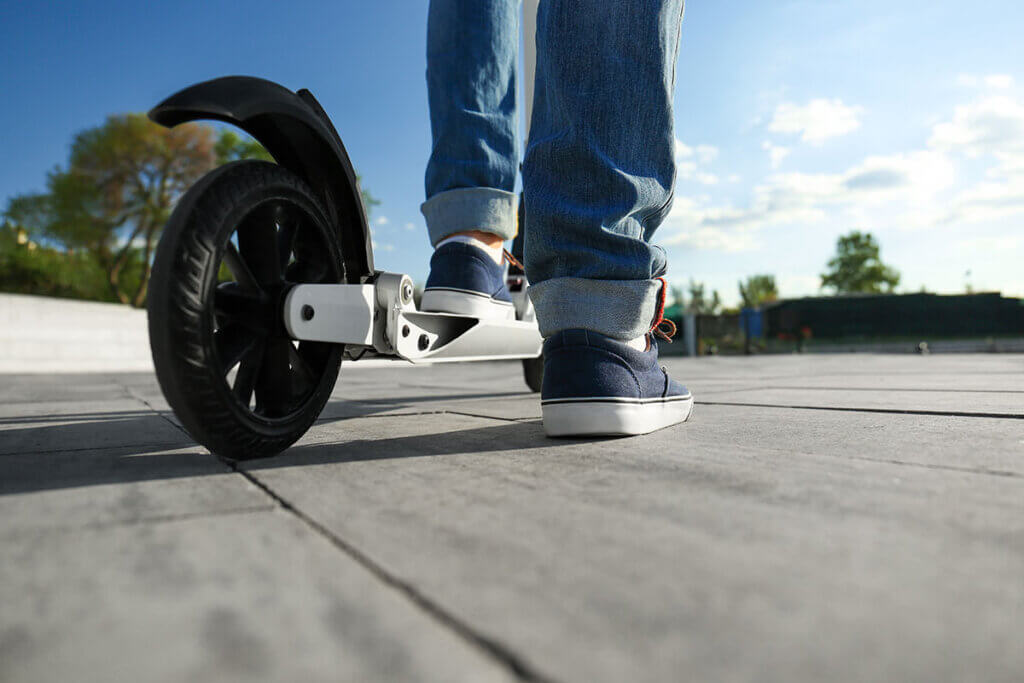
Which tyres are suitable for which surface?
Sporting scooters with small hard rubber wheels are mainly suitable for asphalt. This is mainly due to the low suspension, which makes the rider feel every bump. Riding on rough and uneven surfaces such as cobblestones is not only unpleasant for the user, but also because the ground continuously slows down and destabilises the scooter. Unlike hard rubber wheels, pneumatic tyres compensate for difficult surfaces and provide a smoother ride. Users also notice shocks to a lesser extent. Therefore, sporting scooters with pneumatic tyres make sense as soon as users ride on different surfaces. Due to the suspension, this variant is also recommended for longer distances. Models with hard rubber wheels are suitable for short distances, such as the last kilometres of the commute.
Ball bearings for long-lasting scooter fun
Ball bearings ensure that the wheels of all rollerboard devices function smoothly. Manufacturers use the ABEC scale to indicate their manufacturing quality. It defines tolerance classes for the production of ball bearings. “ABEC” stands for “Annular Bearing Engineering Committee”, the technical committee that developed the scale. The higher the classes, the higher the manufacturing tolerance of the ball bearings. Versions with a value of ABEC 9 have the highest quality workmanship and are correspondingly durable. A value of at least ABEC 5 is advisable.
Pressing on the brakes
Sporting scooters are usually equipped with so-called rear-wheel friction brakes. This brake is a plate made of aluminium or steel that the rider presses against the wheel with his or her foot. This causes friction between the plate and the wheel, so that the scooter brakes.
The wear of the brake is particularly high with the aluminium version. Compared to steel plates, however, less heat develops. In addition, steel causes more abrasion on the material of the wheels. It is advisable to look for high-quality brakes from well-known manufacturers such as Magura.
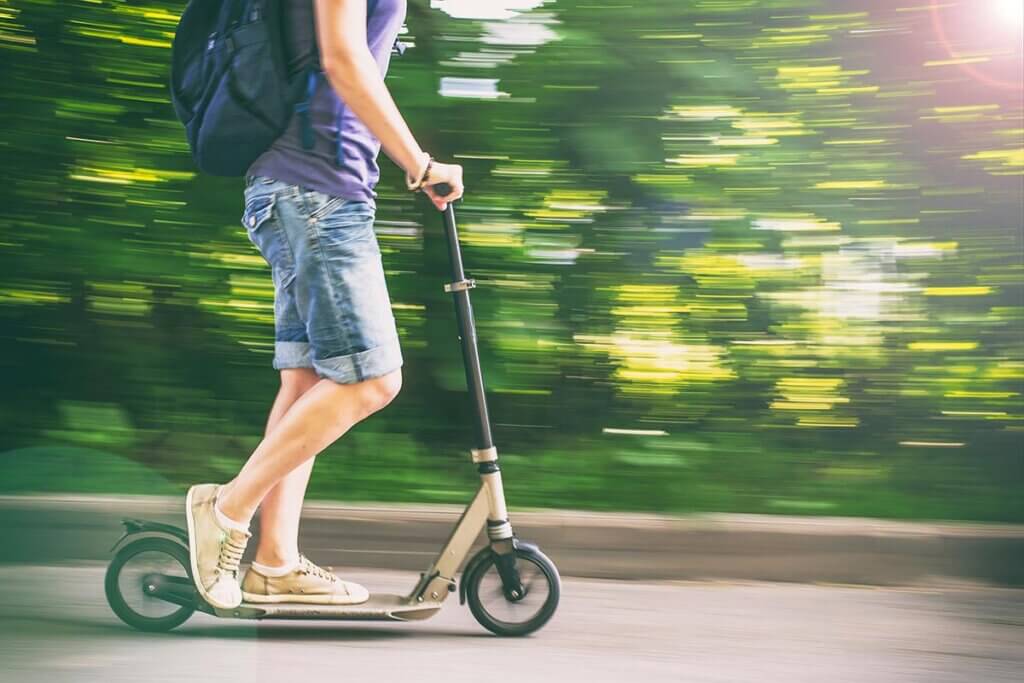
Some higher-priced sporting scooters come with disc brakes. They are located on the rear wheel and can be operated with a hand brake lever on the handlebar. The braking effect is stronger than with rear-wheel friction brakes and is therefore highly recommended on inclines. Using both types of brakes ensures a safe ride.
How much weight does the scooter carry?
The weight of the rider affects the use of the sporting scooter. When buying a scooter, it is important that the chosen model can support the weight of the user. Although there are city scooters with a load capacity of up to 150 kilograms, most smaller models can only withstand 100 kilograms. Sporting scooters designed specifically for children can sometimes carry less than 80 kilograms. Models that have a higher load capacity are often marked with additions such as “XXL”.
Keep the tare weight as low as possible for easy transport
The tare weight of the scooter is important for transport: light models weighing about five kilograms can also be carried by more petite people and children on buses and trains. As a rule, compact and foldable sporting scooters weigh less than eight kilograms. Large scooters for the city have a weight of about 10 to 15 kilograms.
Well-known brands: Apollo | Frenzy |Hudora | JD Bug | Micro |Motoraux | Six Degrees | Xootr
Other types of scooters
Sporting scooters are only one of many types of pedal scooters. The transitions are fluid for some scooter types, making it difficult to get an overview. For example, “tretroller” is the umbrella term for compact sporting scooters as well as bicycle-like scooters with pneumatic tyres up to 29 inches in size. In addition, there are scooters that are designed for special uses such as racing or riding downhill. It is noticeable that the rear wheel of many scooters is smaller than the front one, for example 20 instead of 29 inches.
What are the types of scooter particularly suitable for?
Unlike sporting scooters, scooters with large tyres are particularly suitable for longer distances, such as tours and excursions, but also for an extensive city tour. Conventional scooters are also suitable for improving your fitness. Conventional pedal scooters equipped with a bike aerial as well as a joring line can be used as dogscooters. In dogscooting, the dog is tethered to the shock-absorbing leash and pulls the scooter. The antenna ensures that the leash does not get caught between the wheels. If you see the scooter mainly as a piece of sports equipment and less as a practical means of transport, you can choose special versions for racing and fitness. Scooters for off-road riding are particularly robust and can cope with a wide variety of rough surfaces. For tricks and stunts, small, manoeuvrable stunt scooters are suitable instead of large scooters.
Racing scooters
Racing scooters are suitable for anyone who wants to cover longer distances in the shortest possible time. The design is focused on ergonomics and speed. Therefore, racing scooters are particularly light: their total weight is no more than ten kilograms. They have a large front tyre with an average diameter of 28 inches, a narrow rear tyre with a diameter of about 20 inches and a particularly low footboard with an average diameter of five to eight centimetres. The shorter the footpath to the ground, the better high speeds can be achieved.
Pedal scooters for off-road use
There are two types of off-road scooters: Cross-country scooters for easy to moderately difficult off-road riding and downhill scooters for difficult surfaces and downhill riding. Both types are more robustly built than other pedal scooters and are constructed with wide, resistant tyres from the mountain bike sector.
Cross-country scooters are also known as off-road scooters and are versatile. They are suitable for smooth asphalt roads, uneven paths in town and country as well as off-road. The front wheel of a cross-country scooter has a minimum size of 26 inches, while the rear wheel is at least 20 inches. Disc brakes provide more braking power and a higher footboard prevents damage from obstacles such as roots or stones. In addition, a suspension fork absorbs shocks as well as bumps.
Downhill scooters also have a higher footboard, disc brakes and suspension forks. The tyres also have the same diameter, but are usually wider than on cross-country scooters. In addition, the footboard is non-slip and, together with the frame, particularly stable. Downhill scooters are specially designed for downhill riding and the most difficult terrain.
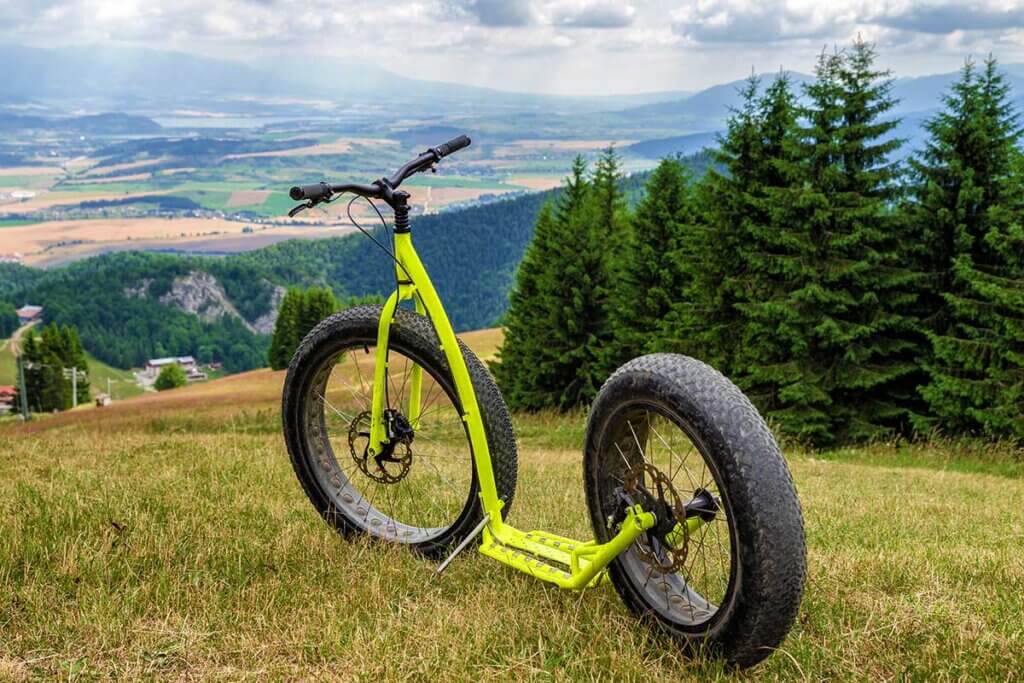
Stunt scooters
Like racing or fitness scooters, stunt scooters are sports equipment. However, their focus is not on speed and endurance, but on jumps and tricks. Externally, they resemble the small sporting scooters with hard rubber wheels, but they are more sturdily built. The handlebars consist of one piece and therefore cannot be adjusted in height or folded. The hard rubber wheels are smaller than those of sporting scooters. They show their strengths in indoor and outdoor skate parks and on asphalt.
So-called dirt scooters are an exception. These are a mixture of off-road pedal scooters and stunt scooters. Instead of hard rubber wheels, the scooters are equipped with pneumatic tyres suitable for off-road use. This allows users to perform tricks on hills, for example.
Closely related: The kickboard
As an alternative to compact sporting scooters and other pedal scooter designs, a kickboard is also a comfortable way to get around town. Their design is similar to mini scooters: handlebars and wheels are connected to a footboard. Here, too, users place one foot on the deck and push off the ground with the other to initiate the movement. Furthermore, kickboards are foldable and thus easy to transport.
Unlike scooters, kickboards have a second front wheel. This makes them more stable and they ride smoother than two-wheeled scooters. They also cope better with uneven roads and cobblestones. Because of the extra wheel, the footboard is also wider, making the deck similar to that of a skateboard.
Another difference is the handlebars. While all scooters are designed with a T-shaped handlebar, these are mainly found on kickboards specifically for children. Most models have a straight handlebar that ends with a knob. The rider steers by shifting the weight in the desired direction while pushing the knob slightly to the appropriate side.
These traffic rules apply
Simple sporting scooters fall into the category of toys and can therefore only be ridden on pavements and in pedestrian zones. Sporting scooters also do not require lights or reflectors, as these are only prescribed for vehicles. On public transport, they are considered luggage, so drivers can take them with them at no extra cost. For bicycles or e-scooters, an appropriate ticket is required.
Since June 2019, e-scooters have been allowed to drive on German roads – provided they have a road permit. If a general operating permit is not available, the vehicles can only be used on private property.
E-scooters are defined as miniature electric vehicles and may only reach a maximum speed of 20 kilometres per hour. A power of 500 watts is the maximum. Drivers may make use of cycle paths, cycle lanes as well as cycle tracks. In the absence of these, use of the carriageway is permitted. Riding on pavements, in pedestrian zones and on one-way streets against the direction of travel is prohibited. The minimum age for riding an electric scooter is 14 years.

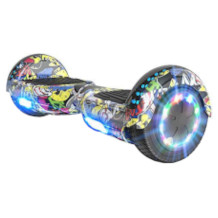
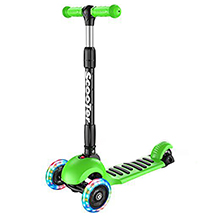
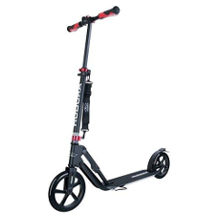
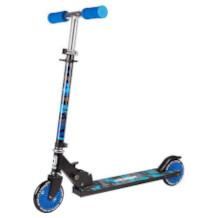
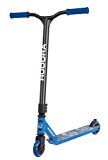
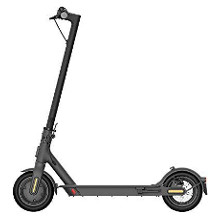
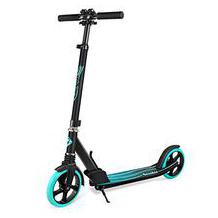
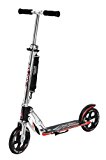


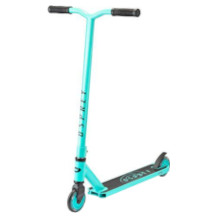

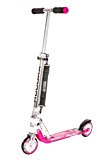
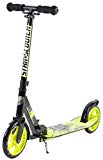
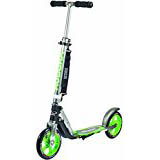
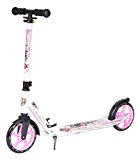

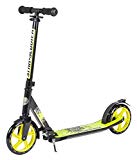
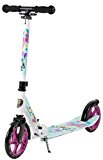
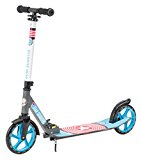
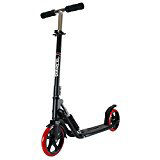


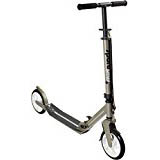
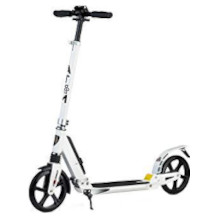

 19,116 reviews
19,116 reviews
